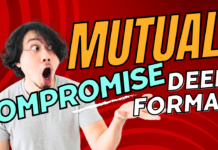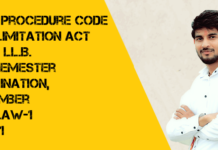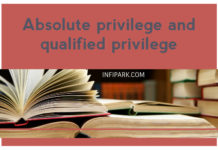State the different kinds of ownership.
Ans. Ownership may be classified under the following heads :
I. Corporeal and incorporeal ownership;
2. Sole ownership and co-ownership;
3. Legal and equitable ownership;
4. Trust and beneficial ownership; .
5. Vested and contingent ownership; and .
6. Absolute and limited ownership;
1. Corporeal and incorporeal ownerships.—The object of owner-ship may be a material thing such as land or lands or goods, or an immaterial thing or right such as a patent trade mark, copyright, reputation or domestic relation. Ownership when it refers to a material object is called corporeal ownership; and where it refers to any other thing or rights, it is called incorporeal ownership. Thus, ownership of land is corporeal. But ownership of an encumbrance is incorporeal.
2. Sole ownership and co-ownership.—Ownership may be either sole or duplicate. When it is vested in one person it is called sole owner-ship ; when it is invested in two or more persons at the same time, it is called duplicate ownership.
The chief instances of duplicate ownership are ;
(i) Co-ownership;
(ii) Trust and beneficial ownership;
(iii) Legal and equitable ownership;
(iv) Vested and, contingent ownership.
Co-owneship that is to say, ownership shared by several persons with equal or co-ordinate results may be of two kinds, namely :—
(a) Joint ownership, and
(b) Ownership-in-common.
(a) ‘Joint ownership’ is that where on death of one of the co-owners the whole right ensures for the benefit of surviving co-owner or co-owneers, until at last when the last survivor of the joint owners, dies, it would devolve on his heirs. The heirs of a predeceased co-owner will not get any share at all in the property of the joint owner.
(b) “Ownership-in-common” is that where, on the death of one of the co-owners, his heirs step into his shoes.
3. Legal and equitable ownership.—English law recognises two forms of ownership—legal and equitable. In England before the passage of Judicature Acts of 1873, and 1875 there existed two kinds of Courts with two quite distinct jurisdictions. These two Courts were known as the Common Law Courts and the Equity Courts.
The rights reognised and protected by the Common Law Courts were called legal or Common Law Rights and the rights enforced by Equity Courts were known as equitable rights.
Legal ownership is, therefore, that ownership which was or recognised by the rules of Common Law, while equitable ownership is that which originated from the rules of equity.
Equitable ownership was thus not recognised by the Common Law Courts. The Chancery or Equity Courts recognised legal ownership as well as the equitable ownership.
Keeton says, “This quality of legal and equitable ownership arises, whenever one person holds the legal title to property, the beneficial en-joyment of which is vested in another. Thus the legal owner is he whom the Common law could designate as the owner ; the Equitable owner is that person whom the Court of Chancery would formerly have protected in the enjoyment of a thing.”
4. Trust and beneficial ownership.—These two forms of owner-ship are related to the institution of a trust. A trust is an instance of duplicate ownership namely, trust ownership and beneficial ownership. In a trust certain property is given in trust or confidence to a person or a definite group of persons to be held under an obligation for the benefit of some other persons or group of persons.
Trust is defined as an obligation annexed to the ownership of property, and arising out of a confidence reposed in and accepted by the owner, or (b) declared and accepted by him for the benefit of the other.
5. Vested and contingent ownership.—Ownership is either vested eontin.zent. It is vested when the owner’s title is already perfect ; it is litingent when his title is as vet imperfect, but is capable of becoming perfect on the fulfilment of some condition or contingency. Vested own-ership is absolute, contingent ownership is conditional. It is subject to conditions and it may be made to commence or cease upon the ascertain-ment that a certain fact does not exist.
Thus, I may be the owner of a piece of land on condition of paying a certain fixed sum of money annually to the State. My ownership is thus conditional on the annual payment of the money.
Contingent ownership is not spes acquisitionis—Simple chance or mere possibility of becoming owners—but more than that. It is more than a mere future possibility but the existence of an inchoate or incomplete title in the present, capable of achieving completion and perfection on the happening of a given contingency in future.
The conditions on which ownership depends may be either ‘condition precedent’ or ‘condition subsequent’. A condition precedent is one by the fulfilment of which a title is completed ; a condition subsequent is one on the fulfilment of which a title already completed is extinguished. In the former case ownership which was formerly conditional becomes ab-solute. In the later case the ownership which is already lost conditionally, is lost absolutely. In case of a condition subsequent ownership is not contingent but vested. For the condition attached to the ownership it is not with regard to commencement of ownership but with regard to conti-nence of it.
6. Absolute and limited ownerships.—When a person has got all the rights in relation to any property we say that absolute ownership vests in him but when some right in relation to property has been re-stricted then the ownership is called limited, one. In Hindu law, before Hindu Succession Act, woman’s estate was a limited ownership. If a Hindu woman inherited property from a male or a female it was called woman’s estate. Such property was held only for her life and she had only a limited power of disposal. When she died the property went to the heirs of the last holder of the property.




















